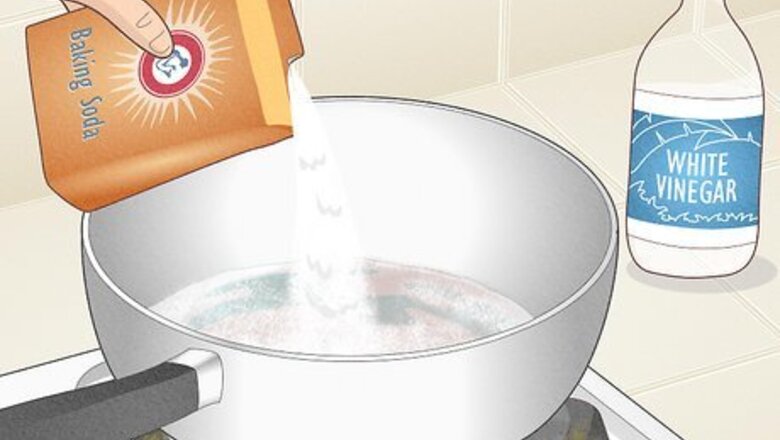
views
Vinegar, baking soda, and water
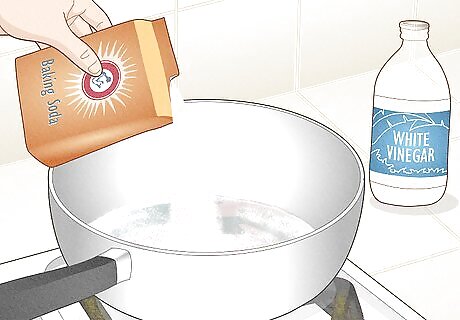
The chemical reaction between the vinegar and baking soda cleans the pot. Coat the bottom of the pot with 1 cup (240 mL) of water and 1 cup (240 mL) of white vinegar, then bring the solution to a boil. Turn off the stove and set the pot down so it’s away from any heat. Drizzle baking soda into the pot. Once the burnt food fizzes up, scrub it off with a scouring pad. Soak your pot to prevent set-in stains. Right after you've burnt food, fill your pot with the solution of vinegar, baking soda, and water to tackle scorch marks. To avoid too much fizz that you'll have to clean up later, pour out the vinegar and water solution before you sprinkle in baking soda. For stubborn stains, make a paste with baking soda and just a couple of drops of water. Apply the paste all over your pot and wait several hours so the mix can penetrate the stains.
Dish detergent and water
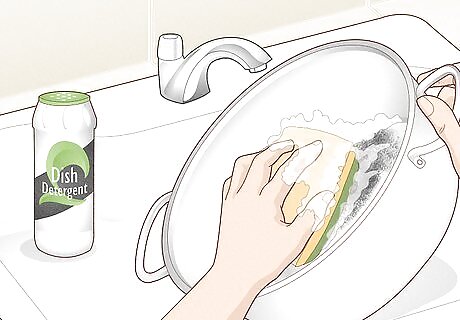
Wash away scorch marks with powdered dish detergent and water. Scoop out 1 tbsp (14.3 grams) of powdered dish detergent and drop it into your pot. Add enough water to bring your cleaning solution to a boil—around 1 cup (240 mL) should work. Bring the mix to a boil and wait 15 minutes. Then, turn off the stove, dump out the hot water, and scrub your pot with a heavy duty scrub sponge. Before emptying the pot, scrape the scorch marks with a spoon to see if the cleaning solution is working and breaking them up or if you need to keep the soapy water in the pot a bit longer. A cleaning method that uses powdered dish detergent and water is great for copper, stone, and enameled cookware since you need to care for these varieties of pots and pans with really gentle products.
Lemon juice and hot water
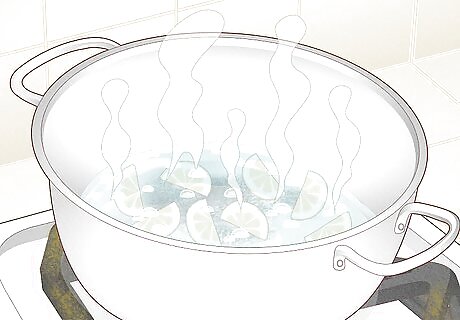
Lemon juice and hot water offer a natural way to dissolve scorched food. Chop up 2 lemons into 8 pieces. Cover the bottom of your pot with the lemon slices. Pour in 1–2 cups (240–470 mL) of water so you cover the scorched bottom of the pot. Bring the water to a boil. Wait for the water to cool, dump it out, and scrub away grime and crust with a kitchen brush. As you boil the water, you should already see flakes of burnt food loosen up. You’ll probably notice brown water at the bottom of the pot. If there are still any scorch marks, they’ll be easy to break up with your kitchen brush. Rinse out your pot once you’ve scrubbed off food particles like burnt noodles. The natural acids in lemon juice work great for treating stains in aluminum cookware.
Salt and dish detergent
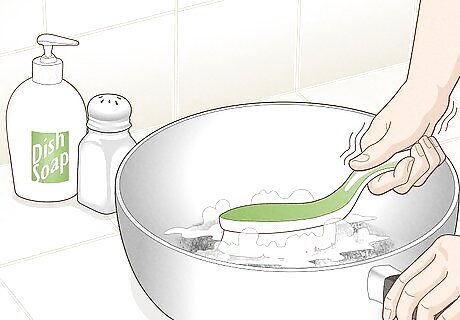
Salt and dish detergent create a slightly abrasive household cleaner. First, coat the bottom of your pot with a thin layer of salt—try 1-2 tbsp (14.3-28.3 grams). Then, pour in 1–2 cups (240–470 mL) of water and add 1-2 drops of liquid dish detergent. Scrub away burnt food particles and scorch marks with a dish brush. For best results, mix coarse salt with fine ground salt. The two varieties will break up both small and large pieces of food. If any burnt residue remains, wash out the pot and repeat this process. Then, give the pot a final rinse.
Alka-Seltzer tablets and hot water
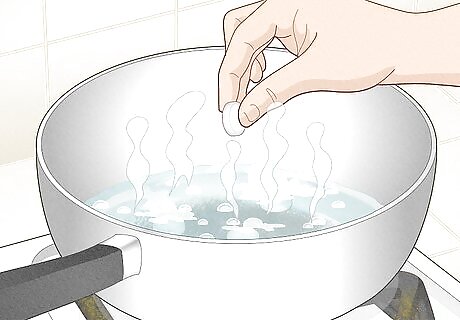
The citric acid in Alka-Seltzer is really effective for dissolving food. Pour 1–2 cups (240–470 mL) of water into the pot and bring it to a boil. Once it bubbles up, drop in 3-4 Alka-Seltzer tablets. Turn off the heat, let the Alka-Seltzer tablets fizz up, and wait 1 hour. When you return, add 1-2 drops of liquid dish detergent to a heavy-duty scrub sponge and wipe away the burnt food. If there's a lot of crust or stubborn stains on your pot, drop in 6 Alka-Seltzer tablets.
Oxalic cleaning powder
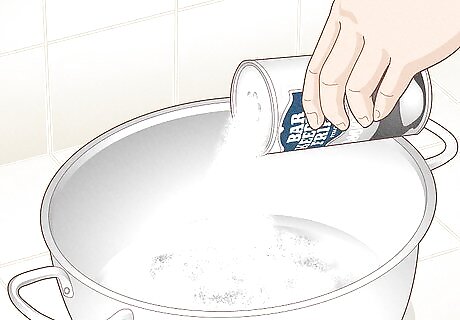
Oxalic cleaning powder is a heavy-duty solution for scorched pots. Use an oxalic acid cleaning powder that you can sprinkle onto your pot—Bar Keepers Friend is a popular choice for cookware. Soak your pot for 20 minutes. Then, drizzle oxalic cleaning powder onto the burnt areas on your pot. Once they’re coated, scrub them with a non-scratch scrub sponge. Be careful not to get any oxalic cleaning powder on your skin or in your eyes. To be extra cautious, wear a particulate respirator mask when you apply it. When you’re done rubbing away stains, rinse out your pot and throw it in the dishwasher to eliminate any residue from oxalic cleaning powder.
Aluminum foil, vinegar, and baking soda
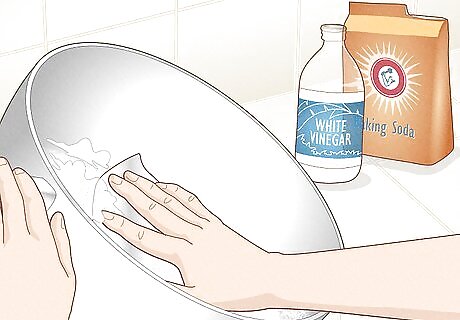
Aluminum foil, vinegar, and baking soda are 3 great non-toxic cleaners. Pour ⁄2 cup (120 mL) of white vinegar into your pot. Then, drizzle 1 tbsp (14.3 grams) of baking soda over the stains in your pot. As the vinegar and baking soda solution bubbles, rub away all the scorched food with a 6 in (15 cm) square piece of aluminum foil. Apply light pressure as you scrub stains with the aluminum foil. Thoroughly wash your pot when you’re done to remove any food particles or flakes of aluminum foil.
Dishwasher tablet
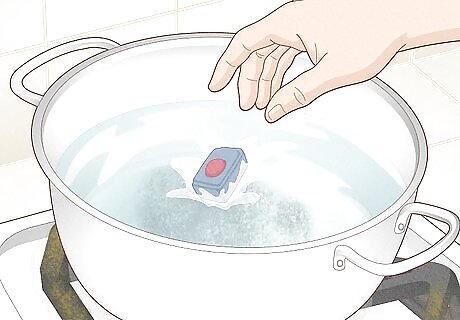
Just 1 dishwasher tablet can dissolve food stains in minutes. Fill half of your pot with water. Once you’re done, drop in a single dishwasher tablet. Bring the water to a boil and wait for 10 minutes. Then, pour out the hot water and let your pot cool down until it’s safe to touch. Finally, scrub away scorched crust with a scouring pad. Dishwasher tablets are formulated to fight food stains, so they’re really effective for washing off burnt residue from your meals.
Dryer sheet
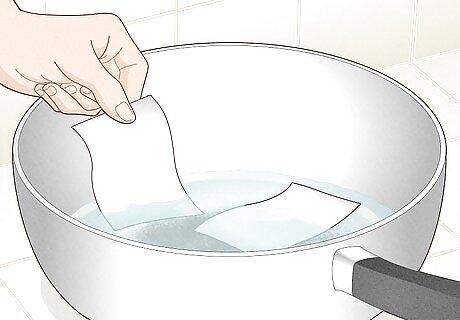
Dryer sheets are a household staple that can actually wash your pots. Drop 1-2 dryer sheets into your pot. Pour in 1–2 cups (240–470 mL) of hot water so they’re fully soaked. Wait 2-3 hours so the chemicals in the dryer sheets can dissolve any food stains. Then, dump out the water and scrub the pot with one of the dryer sheets. After you rub away stains with a dryer sheet, throw your pot in the dishwasher to remove any chemical residue.
Heat
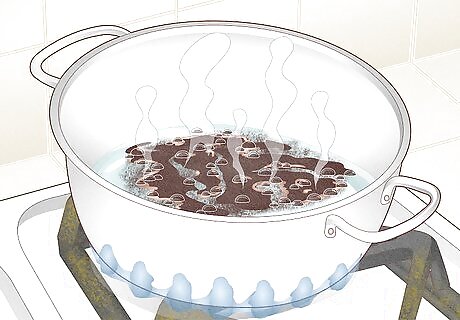
Sometimes, all enamel or stainless steel pots need is a little heat. Place your pot on the stove and turn on the heat to a high temperature that's 212 °F (100 °C) or higher to “deglaze” it, or break up burnt food. Then, pour about 1 cup (240 mL) of lukewarm water into the pot. Aim for spots where burnt food has crusted on. Scrape the burnt food off with a long-handled spatula. After adding the water, step back quickly to avoid any rising steam. To be extra careful, turn off your burner, remove the pot and let it cool before scraping off the food. If you remove the crust while the stove is still hot, wear heat-protective cooking gloves to avoid burns.













Comments
0 comment